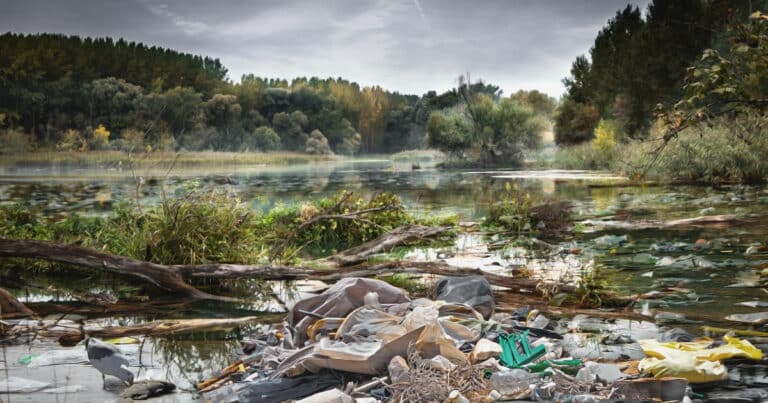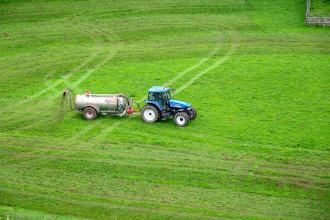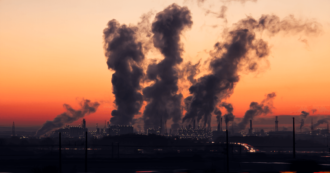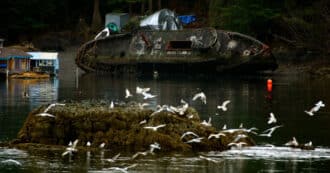By Harry Cooper
The Dangers of Water Pollution
Water pollution has become a prominent problem in today’s world. The world’s population is increasing, and with it, the demand for drinking water. As it becomes increasingly harder to find water, it is important that the water we do have stays clean and drinkable.
Water pollution is dangerous to human life and also to the environment. It is estimated that more people die each year from health problems caused by unclean water than from all war and violent acts. Not only is polluted water putting human lives at risk, but it also has started to make many aquatic species endangered, which can throw entire ecosystems out of balance.
Groundwater Pollution
Groundwater is water found underground in the spaces between soil and fractured rocks. Groundwater is especially important because there are so many people in the world that rely on stores of underground water called aquifers for drinking water. Since these aquifers are replenished with rain water that seeps into the ground, it can make it very easy for harmful toxins to get in as well, causing groundwater pollution.
This type of pollution can come from many different sources. Heavy rain over landfills can cause heavy metals and other chemicals to leach into groundwater supplies. Fertilizers, animal waste, and pesticides found in agriculture can cause nitrates and bacteria to infiltrate into our aquifers. Additionally, septic tanks and sewage systems occasionally leak untreated waste into our groundwater supplies.
Surface Water Pollution
Another one of the types of water pollution is surface water pollution. Surface water pollution refers to any water on the earth’s surface, such as lakes, rivers, and oceans, being polluted. This mainly occurs through chemicals in rainwater drainage. These chemicals come from fertilizers and pesticides that are used in agriculture and lawn-care, chemicals used on roads and highways, and from human waste. When it rains, these harmful toxins are swept into our rivers, lakes, and streams.
Surface water is important for many things, such as ecosystems, drinking water, and recreation. The US Environmental Protection Agency found in its 2000 annual water quality report that “more than 291,000 miles of assessed rivers and streams do not meet water quality standards. Across all types of waterbodies, states, territories, tribes, and other jurisdictions report that poor water quality affects aquatic life, fish consumption, swimming, and drinking water”. With so many water bodies and so much surface water already polluted, the demand for clean water is becoming more and more important.
Ocean Water Pollution
Like lakes and rivers, the ocean is another type of surface water. The world’s oceans are also subject to surface water pollution, and while it may not be a major source of drinking water, it is still important for recreation, plants and animals, and even the quality of our atmosphere.
Phytoplankton are one of the most important factors when it comes to climate change. These single celled organisms live near the surface of every ocean in the world. Phytoplankton spend their days photosynthesizing, taking carbon out of the air, and producing oxygen, and because of their large number, they produce nearly half of all oxygen in the Earth’s atmosphere. However due to water pollution, phytoplankton numbers are dwindling, which is causing climate change to happen faster.
Another important type of water pollution in the ocean is plastic pollution. Most people are familiar with the grim scenes of aquatic life being strangled by plastic bags and vast expanses of sea covered in a layer of grimy trash, but plastic in the ocean can have more of an impact on the environment and human health than we realize.
As plastic is tossed around in the waves and currents of the ocean it slowly breaks down into tiny pieces less than 5mm long called microplastics. Microplastics float in the water as suspended matter and are consumed by small marine organisms. As these organisms are eaten by larger marine animals, the toxic chemicals in the plastics move up the food chain. Scientists have now discovered microplastics in 114 marine animals. Many of the contaminants in the microplastics can prevent some species from reproducing, making the impact plastic has on aquatic life even worse.
Many fish contaminated with microplastics also find themselves on our dinner plates, putting human health at risk to microplastic exposure as well. Researchers say that we don’t know exactly how these contaminants will harm us, but “the potential risk might be high”.
Point Source Pollution
This kind of water pollution is not a pollution of a specific kind of water, but rather where the pollution comes from. Point source pollution is any kind of pollution that comes from one identifiable source. These water pollutants include oil spills, industrial waste, marine dumping, sewage, or any kind of water pollution that can be traced to a single source.
Nonpoint Source Pollution
As the name suggests, nonpoint source pollution is a type of water pollution that does not come from one specific source. This kind of pollution includes wastewater runoff, littering, and agricultural sources. All of these sources of pollution are hard to pinpoint what causes them as they don’t come from a single source, but nonetheless nonpoint source pollution still causes contamination in water bodies.
Eutrophication and Oxygen
We typically don’t think of oxygen as a problem when it comes to water pollution, but having too little oxygen is becoming a problem in many water bodies. This is caused by one of the types of water pollution called eutrophication.
Eutrophication, also called nutrient pollution, occurs when an excess amount of nutrients get into a water body. These nutrients come from industrial and agricultural use of phosphorus and nitrogen that leak into the water system. These nutrients allow for phytoplankton to multiply almost unchecked. These phytoplankton population booms are called algal blooms.
While phytoplankton are usually heroes of the environment as they produce so much oxygen, when a water body has such a high density of these organisms it can cause some problems in the ecosystem. Algal blooms can raise the pH level of the water, release toxic chemicals, limit visibility for animals, and stop plants from photosynthesizing. But the most detrimental effects of eutrophication comes when the blooms eventually die.
When these phytoplankton die, they are decomposed by other microorganisms. This process of decomposition uses up a lot of the oxygen in the water causing severe oxygen depletion. When oxygen gets depleted like this it creates a dead zone. As the name implies, not much can survive in these dead zones due to the little amount of oxygen.
The Main Sources of Water Pollution
As we have seen, there are many different types of water pollution and many different water pollution causes, but what are the main causes of water pollution? The biggest contributors to water pollution include both nonpoint sources, such as wastewater drainage, and point sources such as industrial waste, marine dumping, and sewage. However, while these sources contribute a lot to pollution, a report from the UN Food and Agriculture Organization found that “agriculture is the single largest producer of wastewater, by volume”.
The fertilizers and pesticides that industrial farms use often find themselves in freshwater, saltwater, and underground water sources due to rainwater runoff. The chemicals found in fertilizers and pesticides are responsible for many of the types of water pollution that we have talked about. The UNFAO report said that nitrate from fertilizers is the most prominent harmful chemical found in groundwater pollution. Phosphorus and Nitrogen are also water pollutants found in fertilizers that are the primary causes of eutrophication. And pesticides contain harmful substances that can cause health problems in humans and animals.
Religion and Water Pollution
Many religions see holiness in water, and therefore greatly value its purity. Both Judaism and Christianity require ritual immersion in water, and in the Bible, we read how at the origins of Creation “the Spirit of God was hovering over the waters” (Genesis 1:2). According to Zaharuddin and Sabri, “water is considered one of the most profound elements in Islam… It is also regarded as a blessing from Allah that gives and sustains all life in this world.” Water is fundamental to religions because without it, we couldn’t live.
Unfortunately, despite the high value of water in religion, religions can also be the source of water pollution. For example, this can be seen in the pollution of the Ganges river with dead bodies, ashes and ceremonial flowers. With a little creativity, however, we can find solutions to save our water without taking away from our religions.
An amazing example of this creativity can be seen in the transition away from throwing ceremonial flowers into the Ganges. These flowers are used for devotional activities in temples and mosques and so they can’t simply be thrown away due to their holy status. However, these mass produced flowers, which are often covered with pesticides and plastic can pollute the Ganges with an estimated 8 ton of them being thrown into the river each year.
Ankit Angwar saw how much harm these flowers were causing and worked with religious people and leaders to instead recycle these flowers. They hire mostly women from disadvantaged backgrounds to sort through them and then they spray them with chemicals that neutralize pesticides. A number of products have been created from these flowers, such as incense and compost. They even accidentally created a biodegradable vegan leather from the flower remains that won PETA India’s Best Fashion Innovation Award. Religions can create water pollution and be part of the problem, but with a little ingenuity, they can also help create amazing solutions for our environmental problems that go far beyond what we ever could have imagined.
What Can We do About Water Pollution?
There are many ways of changing the way we produce things and live our lives that can help end water pollution. Many farmers are advocating for greener agricultural practices such as using organic fertilizers and pesticides with less phosphorus, nitrogen, and other dangerous chemicals.
Also, many places in the world are getting better access to water treatment technology, as well as new, more efficient water treatment technology being developed every day. These technologies will make it easier to sanitize waste water and make it clean and drinkable.
Humanity has also started to come together to try and solve the problem of water pollution. The UN has is already taking steps toward ending pollution in our planet’s waters. The sect of the UN called the Global Program of Action for the Protection of the Marine Environment from Land-based Activities (GPA) was formed in 1995 in order to help combat pollution. Since then the GPA has been working to create plans on how to tackle pollution and allocate funds to help countries establish water treatment methods.
While a lot of our limited water has become polluted, humanity has started to cooperate to repair our oceans, lakes, rivers, and groundwater. We have a long way to go before the waters of the world are clean, but it is nice to know that humanity is starting to take steps in the right direction.
* Featured image source







